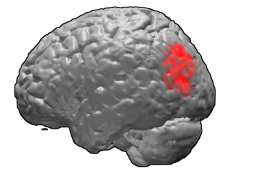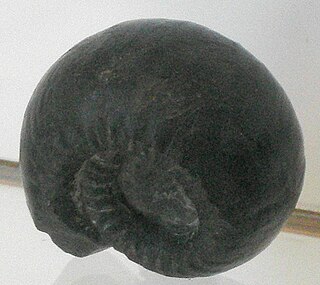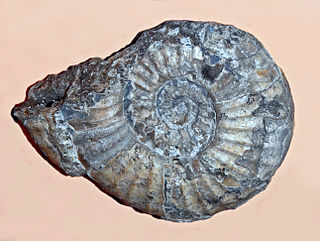
Brodmann area 39, or BA39, is part of the parietal cortex in the human brain. BA39 encompasses the angular gyrus, lying near to the junction of temporal, occipital and parietal lobes.

Goniatites is a genus of extinct cephalopods belonging to the family Goniatitidae, included in the superfamily Goniatitaceae. Hibernicoceras and Hypergoniatites are among related genera.

Gastrioceratoidea is one of 17 superfamilies in the suborder Goniatitina, ammonoid cephalopods from the Late Paleozoic.

Aturia is an extinct genus of Paleocene to Miocene nautilids within Aturiidae, a monotypic family, established by Campman in 1857 for Aturia Bronn, 1838, and is included in the superfamily Nautilaceae in Kümmel 1964.

Psiloceratoidea is a superfamily of Early Jurassic ammonoid cephalopods proposed by Hyatt in 1867, assigned to the order Ammonitida. They were very successful during Hettangian and Sinemurian. Last of them, family Cymbitidae and genera Hypoxynoticeras and Radstockiceras survived into Early Pliensbachian.
Tetragonoceras is an extinct prehistoric nautiloid genus from the nautilid family Tetragonoceratidae that lived during the Middle Devonian, found in Canada.

The Trigonoceratoidea are a superfamily within the Nautilida that ranged from the Devonian to the Triassic, thought to have contained the source for the Nautilaceae in which Nautilus is found.

Rutoceratidae is a family of prototypical nautilids, derived probably from either Brevicoceratidae or Acleistoceratidae of the order Oncocerida early in the Devonian. Rutoceratidae comprise a family within the oncocerid superfamily Tainocerataceae They are generally characterized by cyrtoconic and gyroconic shells, commonly with spines, nodes, or frills, although some included genera are almost orthoconic, and a commonly empty, tubular ventral siphuncle.
Syringonautilidae is a family of Nautiloidea from the middle to late Triassic. Syringonautilidae comprise the last of the Trigonoceratoidea and are the source for the Nautilaceae which continued the Nautiloidea through the Mesozoic and into the Cenozoic right down to the recent. Syringonautilidae is a strictly Triassic family, derived early in the Triassic from the Grypoceratidae.

Grypoceratidae is the longest-lived family of the Trigonoceratoidea, or of the near equivalent Centroceratina; members of the Nautilida from the Upper Paleozoic and Triassic.
The Centroceratidae is the ancestral family of the Trigonoceratoidea and of the equivalent Centroceratina; extinct shelled cephalopods belonging to the order Nautilida
The Naedyceras group comprises three similar and closely related openly coiled, gyroconic, genera within oncocerid family, Brevicoceratidae: Naedyceras, Gonionaedyceras, and Gyronaedyceras.
Gonionautilidae is a family in the nautilid superfamily Clydonautiliaceae that contains only the genus Gonionautilus, known from the Upper Triassic (Norian) of Europe and North America.
Oxygonioceras is a genus in the Oncocerid family, Brevicoceratidae, from the Middle Silurian of North America and Europe.
Koninckioceratidae is a family of nautilid genera, typically with more or less evolute shells with depressed whorl sections, that are combined as a family within the Tainocerataceae. As perceived, the Koninckioceratidae contains 11 genera and lasted from the Early Mississippian to about the end of the Permian.
Edaphoceras is a genus of koninckioceratid nautilids from the Mississippian of North America, named by Hyatt, 1884, with depressed whorls just in contact. The shell, as typical for the family, is evolute; whorl section is fusiform with broadly rounded venter and dorsum meeting at a narrow angle on either side. Its suture has a distinct ventral and dorsal lobe and an angular lateral saddle. The siphuncle is small and near central.
Subvestinautilus is a genus of evolute koninckioceratids, in the order Nautilida, with a depressed, trapezoidal whorl section. The venter is broadly rounded, ventrolateral shoulders sharply rounded, flanks flattened and converging toward a narrow rounded dorsum. In early growth stages a keel forms on the umbilical shoulder which becomes rounded or marked by a longitudinal rib at maturity. The suture has a broadly rounded ventral lobe and a deeper lateral lobe.
Nassauoceras is a tetragonoceratid nautiloid from the Middle Devonian of Europe, the shell of which is evolute with a wide, deep umbilicus, slight dorsal impression, low arched venter, rounded ventral shoulders, and flanks that converge dorsally so as to produce a subtrigonal whorl section. Nodes are present on the ventral shoulders. Sutures have shallow ventral and lateral lobes. The siphuncle is near the ventral margin.
Tylodicoceras is a genus of the Koninckioceratidae from the Devonian thru Mississippian of North America with a large, slightly involute, discoidal shell that is rounded laterally and concave ventrally. Their sides bear a single row with large rounded nodes.
Flickiidae is a family of dwarf ammonites with little ornament and very simples sutures known from small pyritic specimens found in middle Cretaceous deposits. Inclusion in the Acanthoceratoidea is tentative.






